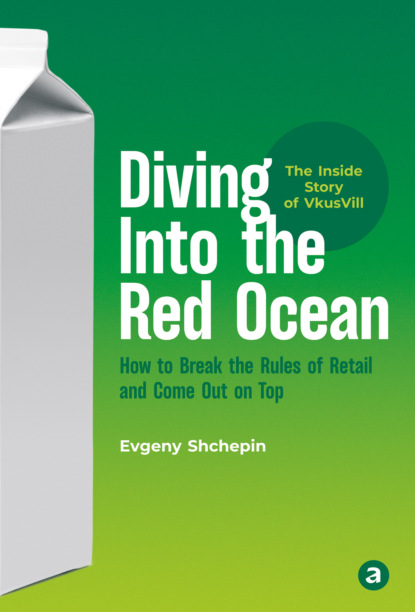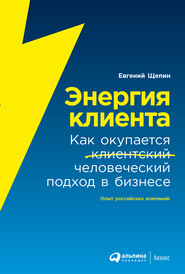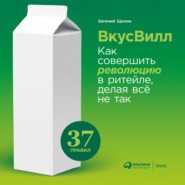По всем вопросам обращайтесь на: info@litportal.ru
(©) 2003-2024.
✖
Diving Into the Red Ocean. How to Break the Rules of Retail and Come Out on Top
Настройки чтения
Размер шрифта
Высота строк
Поля
The earlier you have a conceptual crisis, the better. Izbyonka went through it for a year and a half of its existence, and this period changed the entire company for the better.
By the end of 2010 and the beginning of 2011, Izbyonka had nineteen office workers, about eighty salesclerks and assistants, and the company served thirty-one retail locations.
It was a period of radical reengineering of the Izbyonka project. The key processes were well-managed, and that allowed us to focus on the product offering. We were opening new retail locations and attracting new customers. However, we were faced with an unexpected and vexing problem. A large-scale survey of our clients showed that most repeat customers did not trust Izbyonka. They were drawn to us for our unique products, such as Mechnikov Prostokvasha (a type of fermented milk) and cottage cheese casserole, but they would have been more than happy to buy these products from better-known brands had they offered them. In other words, most of our customers WERE FORCED to visit Izbyonka. This shocking revelation forced us to examine our intoxicating success in a different light. What we perceived as the demand for our products was the lack of alternatives rather than our products' intrinsic value. That fact made the company extremely fragile and vulnerable.
Thankfully, the book Corporate Religion[4 - Jesper Kunde.Corporate Religion: Building a Strong Company Through Personality and Corporate Soul (London: Financial Times Management, 2000).] by Jesper Kunde fell into our hands at about the same time. This book radically changed our relationship to brand positioning. And thanks to Kunde, for the first time we considered the importance of a unified business concept.
Kunde's example of SAS was an organization with a clear and well-defined concept: "to become the best airline for business travel." Everything at SAS was subordinate to this idea, which immediately defines what planes the airline needs, which drinks to serve, which newspapers to offer, etc.
We had cherished the dream that Izbyonka would become an irreplaceable part of the lives of intelligent Muscovites and that we could change their habits and tastes. But how does a brand become a religion? Are there step-by-step instructions for the process? This is where Kunde's work came in handy for us.
The primary message of Corporate Religion is that customers are not naturally inclined to be content with advertising slogans. People are looking for a narrative or message that confirms their faith in a brand. Emotional values are replacing material values – and this is where we found room for growth.
We analyzed Izbyonka based on the algorithm that Kunde proposed: How do we see ourselves? How do others see us? How should people see us? The result was a depressing diagram (Fig. 1).
In an ideal world, all three circles should intersect. The deeper they integrate with each other, the stronger and more successful the company becomes, and the more self-explanatory the concept will become.
Our situation was the reverse: our customers did not understand what we wanted to say to them with our products: we said one thing, but the customers interpreted it in a completely different way.
We had to find a solution to this pressing problem.
The beginning of the solution was the creation of the unified concept department in 2011, which was led by – and is still curated by – Alena Nesiforova, that valiant girl who swapped Paris and Barcelona for Kaluga and Ryazan.
Alena's task was a formidable one: to develop a unified concept for Izbyonka that would convey the company's core values to its customers and rally employees together around a shared idea, just as Dr Kunde had proposed.
"It was one of the most challenging but exciting periods ever, which I am happy and proud to look back on today," says Alena with a smile. "We analyzed the positive aspects of our company and found that there were several: we offered natural foods without chemical additives, short shelf lives for products, assiduous quality control, pleasant service, and producers who were committed to our values and who hailed from different regions in Russia. But these different pieces of the jigsaw did not form a whole for our customers. They considered us to be just another dairy kiosk: if we disappeared, so be it. For the majority, it would not be a major tragedy. But our goal had never been to sell milk. We set out to change the culture of food for Muscovites. We just forgot to tell the Muscovites."
Вы ознакомились с фрагментом книги.
Приобретайте полный текст книги у нашего партнера:
Приобретайте полный текст книги у нашего партнера:









